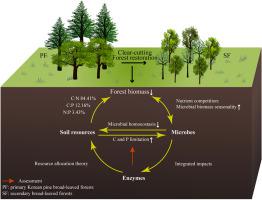Soil and Tillage Research ( IF 6.1 ) Pub Date : 2021-11-14 , DOI: 10.1016/j.still.2021.105260 Dandan Qi 1 , Fujuan Feng 1 , Chang Lu 1 , Yanmei Fu 1, 2

|
The balance of C, N, and P in plants, soil, and microbes is remarkably important for maintaining forest ecosystem stability. However, during forest transitions, the potential effects of the stoichiometric changes and correlations of different soil components on forest restoration are not clear. The restoration characteristics and ecological services of secondary forests, the world’s major forest resources, have been a hot topic of concern. In this study, we used primary Korean pine broad-leaved forests (PF) as controls and investigated the characteristics of the stoichiometry of different soil components and the microbial resource limitation in young and middle-aged (60 years) secondary broad-leaved forests (SF), which were formed after clear-cutting of PF. We found that soil resources, microbial biomass, enzymes, and their stoichiometry varied considerably with the period of sampling within the growing season, and the influence of sampling period was usually greater than that of forest type. Among the stoichiometric ratios of soil resources, the C/N ratio was found to be an important stoichiometric indicator, explaining 84.41% of the variation in forest biomass between the two forest types, and the soil C/N ratio of the SF was remarkably lower. Compared with soil microbial biomass in PF, that in SF exhibited obvious competitive patterns with plants and sensitive homeostasis regulation, suggesting that, in SF, soil microbes competed more strongly with plants for nutrients, and microbial metabolism was more susceptible to the changes in soil resources. In addition, with the exception of β-1,4-glucosidase, the seasonal coefficients of variation for β-1,4-N-acetylglucosaminidase, leucine arylamidase, and acid phosphatase were all significantly larger in SF. The temporal heterogeneity of soil enzymes between the two forest types was mainly related to the dynamic changes of microbial biomass C. The results of eco-enzymatic stoichiometry indicated that soil microbes in the two forest types were restricted by P, but the P limitation was more obvious in SF. Soil microbes in SF were more limited by C. Finally, the correlation analysis revealed that the stoichiometric ratios of the different soil components formed a complex network.
中文翻译:

温带针阔混交林向次生林过渡后不同土壤成分的C:N:P化学计量
植物、土壤和微生物中碳、氮、磷的平衡对于维持森林生态系统的稳定性非常重要。然而,在森林转型期间,不同土壤成分的化学计量变化和相关性对森林恢复的潜在影响尚不清楚。作为世界主要森林资源的次生林的恢复特征和生态服务一直是人们关注的热点。在这项研究中,我们以原始红松阔叶林(PF)为对照,研究了中青年(60 年)次生阔叶林不同土壤成分的化学计量特征和微生物资源限制。 SF),它是在PF清晰切割后形成的。我们发现土壤资源、微生物生物量、酶、它们的化学计量在生长季内随采样周期变化较大,采样周期的影响通常大于森林类型的影响。在土壤资源的化学计量比中,C/N比被发现是一个重要的化学计量指标,解释了两种森林类型之间84.41%的森林生物量变化,SF的土壤C/N比显着较低. 与 PF 土壤微生物生物量相比,SF 与植物的竞争模式明显,稳态调节敏感,表明 SF 土壤微生物与植物对养分的竞争更加强烈,微生物代谢更容易受到土壤资源变化的影响. 此外,除了 采样周期的影响通常大于森林类型的影响。在土壤资源的化学计量比中,C/N比被认为是一个重要的化学计量指标,解释了两种森林类型之间84.41%的森林生物量变化,SF的土壤C/N比显着较低. 与 PF 土壤微生物生物量相比,SF 与植物的竞争模式明显,稳态调节敏感,表明 SF 土壤微生物与植物对养分的竞争更加强烈,微生物代谢更容易受到土壤资源变化的影响. 此外,除了 采样周期的影响通常大于森林类型的影响。在土壤资源的化学计量比中,C/N比被发现是一个重要的化学计量指标,解释了两种森林类型之间84.41%的森林生物量变化,SF的土壤C/N比显着较低. 与 PF 土壤微生物生物量相比,SF 与植物的竞争模式明显,稳态调节敏感,表明 SF 土壤微生物与植物对养分的竞争更加强烈,微生物代谢更容易受到土壤资源变化的影响. 此外,除了 发现 C/N 比是一个重要的化学计量指标,解释了两种森林类型之间 84.41% 的森林生物量变化,SF 的土壤 C/N 比显着较低。与 PF 土壤微生物生物量相比,SF 与植物的竞争模式明显,稳态调节敏感,表明 SF 土壤微生物与植物对养分的竞争更加强烈,微生物代谢更容易受到土壤资源变化的影响. 此外,除了 发现 C/N 比是一个重要的化学计量指标,解释了两种森林类型之间 84.41% 的森林生物量变化,并且 SF 的土壤 C/N 比显着降低。与 PF 土壤微生物生物量相比,SF 与植物的竞争模式明显,稳态调节敏感,表明 SF 土壤微生物与植物对养分的竞争更加强烈,微生物代谢更容易受到土壤资源变化的影响. 此外,除了 SF 中表现出明显的与植物竞争模式和敏感的稳态调节,表明在 SF 中,土壤微生物与植物对养分的竞争更加强烈,微生物代谢更容易受到土壤资源变化的影响。此外,除了 SF 中表现出明显的与植物竞争模式和敏感的稳态调节,表明在 SF 中,土壤微生物与植物对养分的竞争更加强烈,微生物代谢更容易受到土壤资源变化的影响。此外,除了β -1,4-葡糖苷酶,变异为季节性系数β -1,4- Ñ -acetylglucosaminidase,亮氨酸芳基酰胺酶,和酸性磷酸酶都在SF显著大。两种森林类型土壤酶的时间异质性主要与微生物生物量 C 的动态变化有关。在SF中很明显。SF 中的土壤微生物更受 C 的限制。最后,相关性分析表明,不同土壤成分的化学计量比形成了一个复杂的网络。









































 京公网安备 11010802027423号
京公网安备 11010802027423号